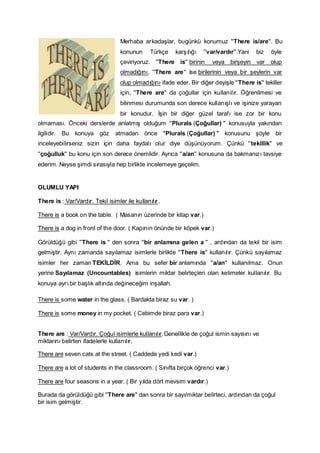
There is are konu anlatımı
- 1. Merhaba arkadaşlar, bugünkü konumuz ''There is/are''. Bu konunun Türkçe karşılığı ''var/vardır''.Yani çeviriyoruz. ''There is'' birinin biz öyle veya birşeyin var olup olmadığını, ''There are'' ise birilerinin veya bir şeylerin var olup olmadığını ifade eder. Bir diğer deyişle ''There is'' tekiller için, ''There are'' da çoğullar için kullanılır. Öğrenilmesi ve bilinmesi durumunda son derece kullanışlı ve işinize yarayan bir konudur. İşin bir diğer güzel tarafı ise zor bir konu olmaması. Önceki derslerde anlatmış olduğum ''Plurals (Çoğullar) '' konusuyla yakından ilgilidir. Bu konuya göz atmadan önce ''Plurals (Çoğullar) '' konusunu şöyle bir inceleyebilirseniz sizin için daha faydalı olur diye düşünüyorum. Çünkü ''tekillik'' ve ''çoğulluk'' bu konu için son derece önemlidir. Ayrıca ''a/an'' konusuna da bakmanızı tavsiye ederim. Neyse şimdi sırasıyla hep birlikte incelemeye geçelim. OLUMLU YAPI There is : Var/Vardır. Tekil isimler ile kullanılır. There is a book on the table. ( Masanın üzerinde bir kitap var.) There is a dog in front of the door. ( Kapının önünde bir köpek var.) Görüldüğü gibi ''There is '' den sonra ''bir anlamına gelen a '' , ardından da tekil bir isim gelmiştir. Aynı zamanda sayılamaz isimlerle birlikte ''There is'' kullanılır. Çünkü sayılamaz isimler her zaman TEKİLDİR. Ama bu sefer bir anlamında ''a/an'' kullanılmaz. Onun yerine Sayılamaz (Uncountables) isimlerin miktar belirteçleri olan kelimeler kullanılır. Bu konuya ayrı bir başlık altında değineceğim inşallah. There is some water in the glass. ( Bardakta biraz su var. ) There is some money in my pocket. ( Cebimde biraz para var.) There are : Var/Vardır. Çoğul isimlerle kullanılır.Genellikle de çoğul ismin sayısını ve miktarını belirten ifadelerle kullanılır. There are seven cats at the street. ( Caddede yedi kedi var.) There are a lot of students in the classroom. ( Sınıfta birçok öğrenci var.) There are four seasons in a year. ( Bir yılda dört mevsim vardır.) Burada da görüldüğü gibi ''There are'' dan sonra bir sayı/miktar belirteci, ardından da çoğul bir isim gelmiştir.
- 2. NOT: Örneklerin Türkçe'lerine baktığınızda, dilimizin yapısı gereği biz çoğulluk belirten bir ifadeden sonra sözcüğe -ler/lar çoğul eki getirmeyiz.Yani hem miktar ifadeleri hem de -ler/lar bir arada olmaz.Yani; There are seven cats at the street. Bu cümleyi çevirdiğimizde; ''Caddede yedi kedi var'' diye çeviririz. ''Caddede yedi kediler var'' şeklinde değil. Ancak İngilizce'de çoğul ifadeler her şekilde yazılır. İngilizce ile Türkçe arasındaki dil yapısından ötürü yukarıdaki gibi çeviriler olmaktadır. Lütfen bu noktaya dikkat edelim. Yoksa hataya düşebiliriz. OLUMSUZ YAPI Yok/Yoktur şeklinde Türkçe'ye çevrilir. Önceki konularda anlatmaya çalıştığım gibi, İngilizce'de bir yapıyı olumsuz yapmak son derece kolaydır.Sadece 2.öğeden sonra ''not'' ya da kısa yazılışı olan ''n't'' getiririz. Bu kuraldan yola çıkarak; There is a key on the table. There isn't a key on the table.( Masanın üzerinde bir anahtar yok.) There is a tree in the garden. There isn't a tree in the garden. ( Bahçede bir ağaç yok.) There are five students here. There aren't five students here.(Burada beş öğrenci yok.) There are twelve months in a year. There aren't twelve months in a year.( Bir yılda on iki ay yoktur. ) Dikkat ettiyseniz olumlu cümleler ile olumsuz cümleler arasında sadece '' n't '' var farklı olarak. Geriye kalan her şey aynıdır. is--isn't, are---aren't olmuştur sadece.
- 3. SORU YAPISI Var mı? şelinde çevirisini yaparız. Soru yaparken en genel kuralımız 1. öğe ile 2.öğenin yer değiştirmesidir. Bu kuraldan yola çıkarak diyebiliriz ki ''is'' ve ''are'' cümle başına gelir. Hepsi bu kadar. Şöyle ki; There is a picture on the wall.( Duvarda bir resim var.) Kural gereği '' is '' başa gelir. Is there a picture on the wall? (Duvarda bir resim var mı? ) There are two apples in the basket. ( Sepette iki elma var.) Kural gereği '' are '' başa gelir Are there two apples in the basket? ( Sepette iki elma var mı? ) Gördüğünüz gibi '' is '' ve '' are '' cümle başına gelmiştir. Cümlenin geri kalanı aynı yazıldı. Cevap verirken ise, yerlerini değiştirdiğimiz ''is/are'' ve ''there'' eski yerlerine yazılır.Tabi ''Yes'' ve ''No'' ile birlikte. Olumlu cevapta ''Yes, there is./ Yes, there are.'' Olumsuz cevapta ''No,there isn't./ No, there aren't.'' Umarım bu çalışmam size faydalı olmuştur arkadaşlar. Buraya kadar anlattıklarımın tablo şeklinde gösterilişi ise aşağıdadır. Tekrar etmiş olmak için bakmanızda fayda var diye düşünüyorum.
